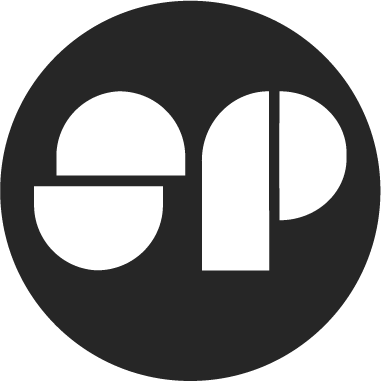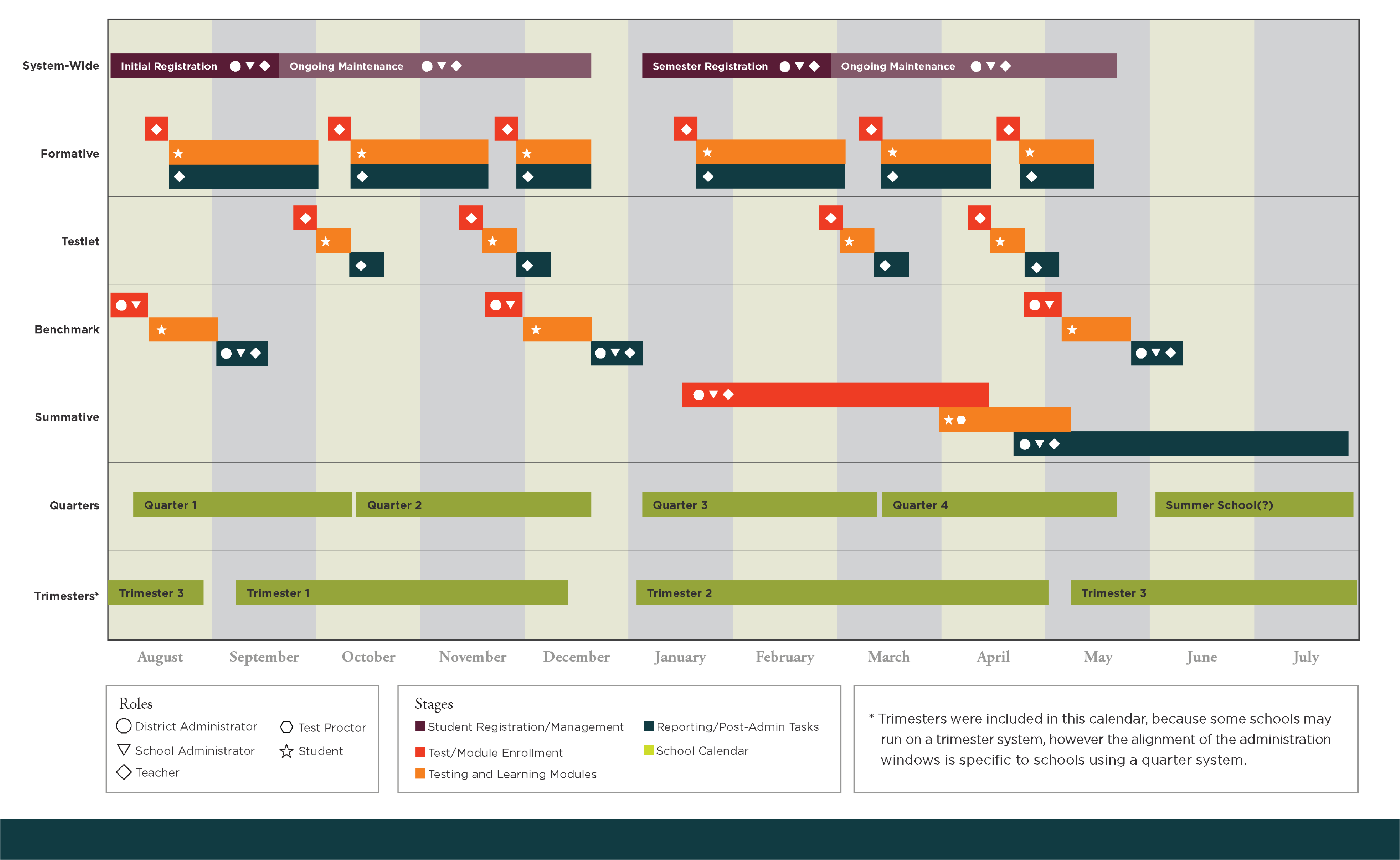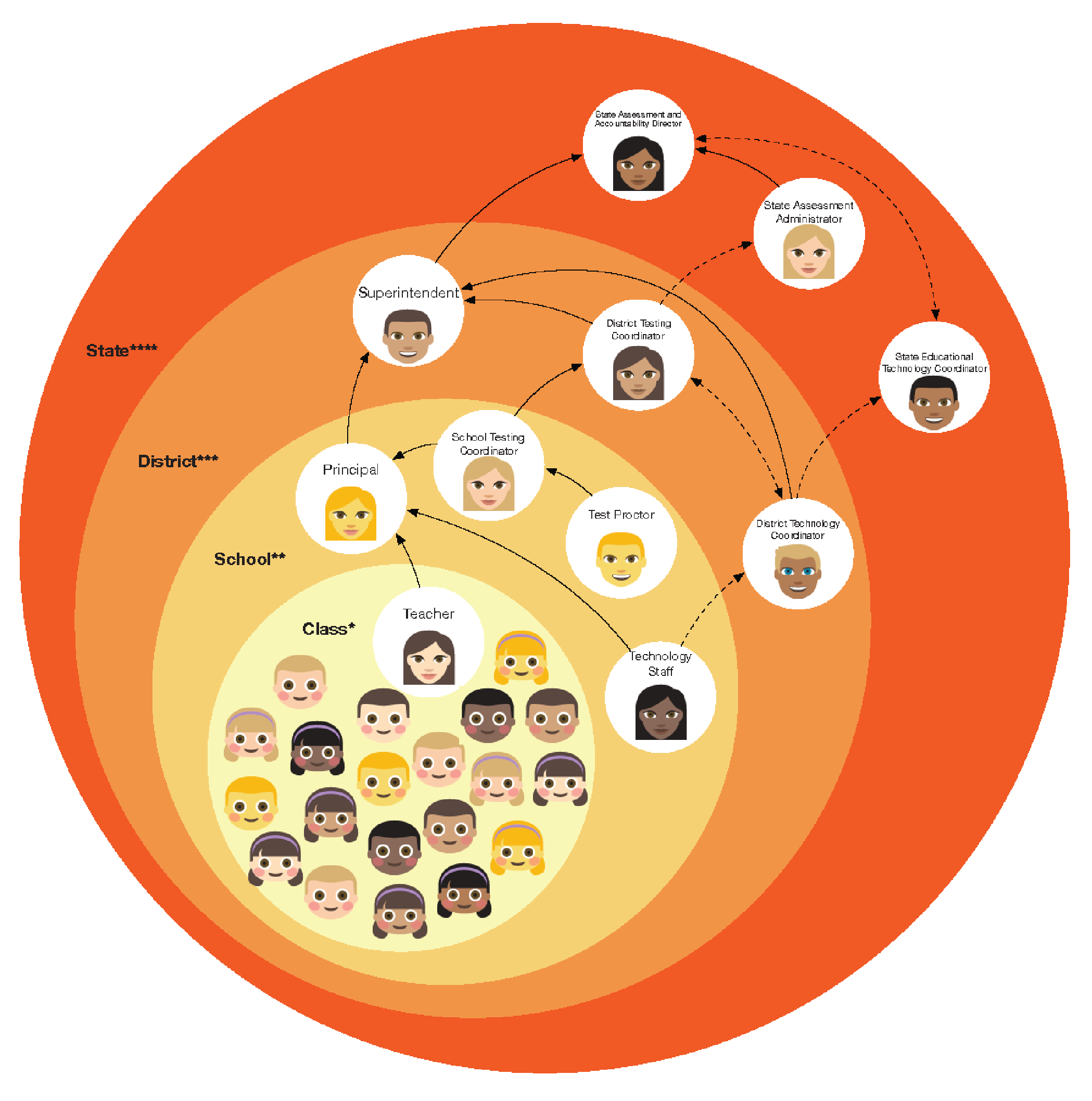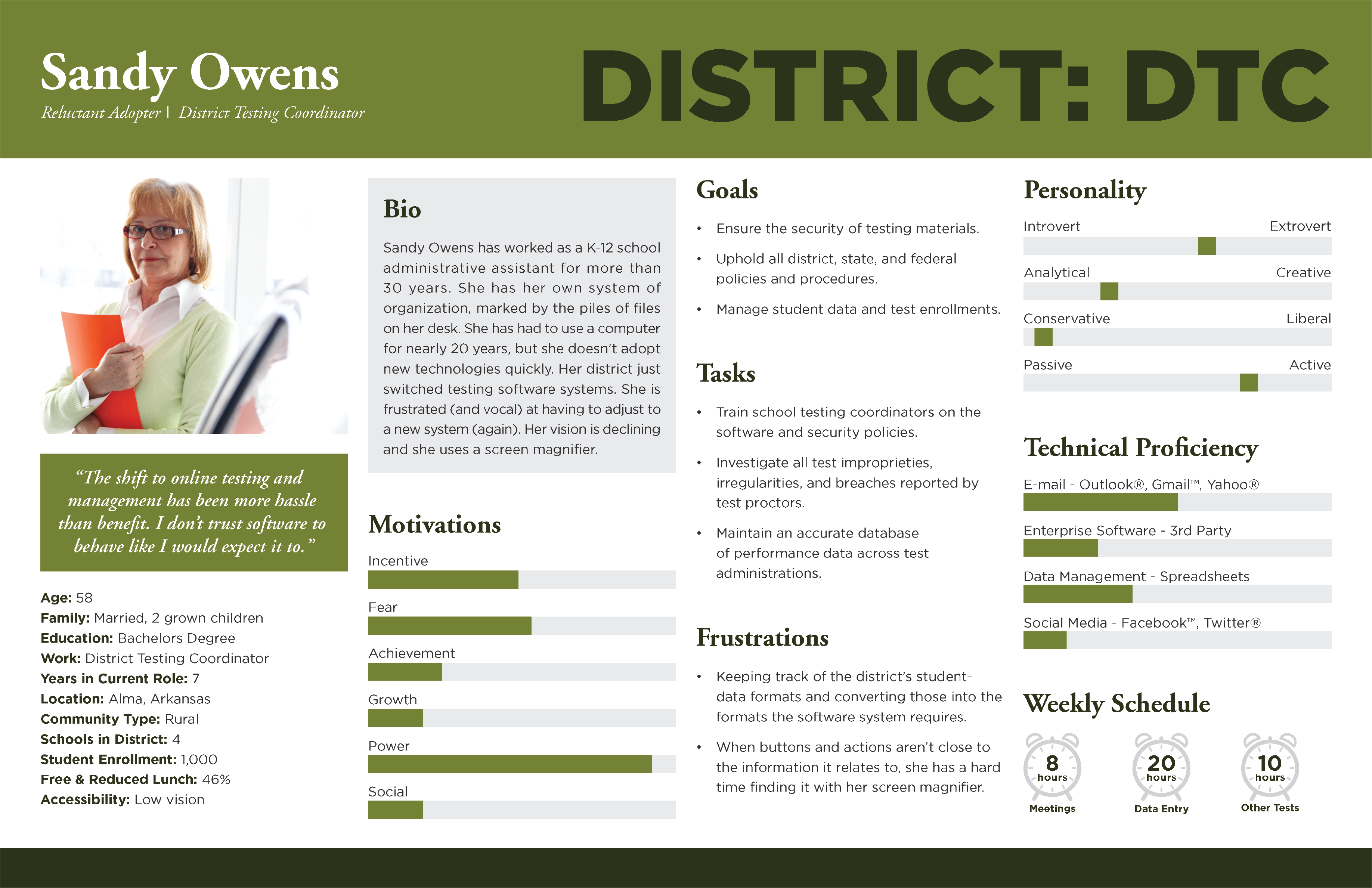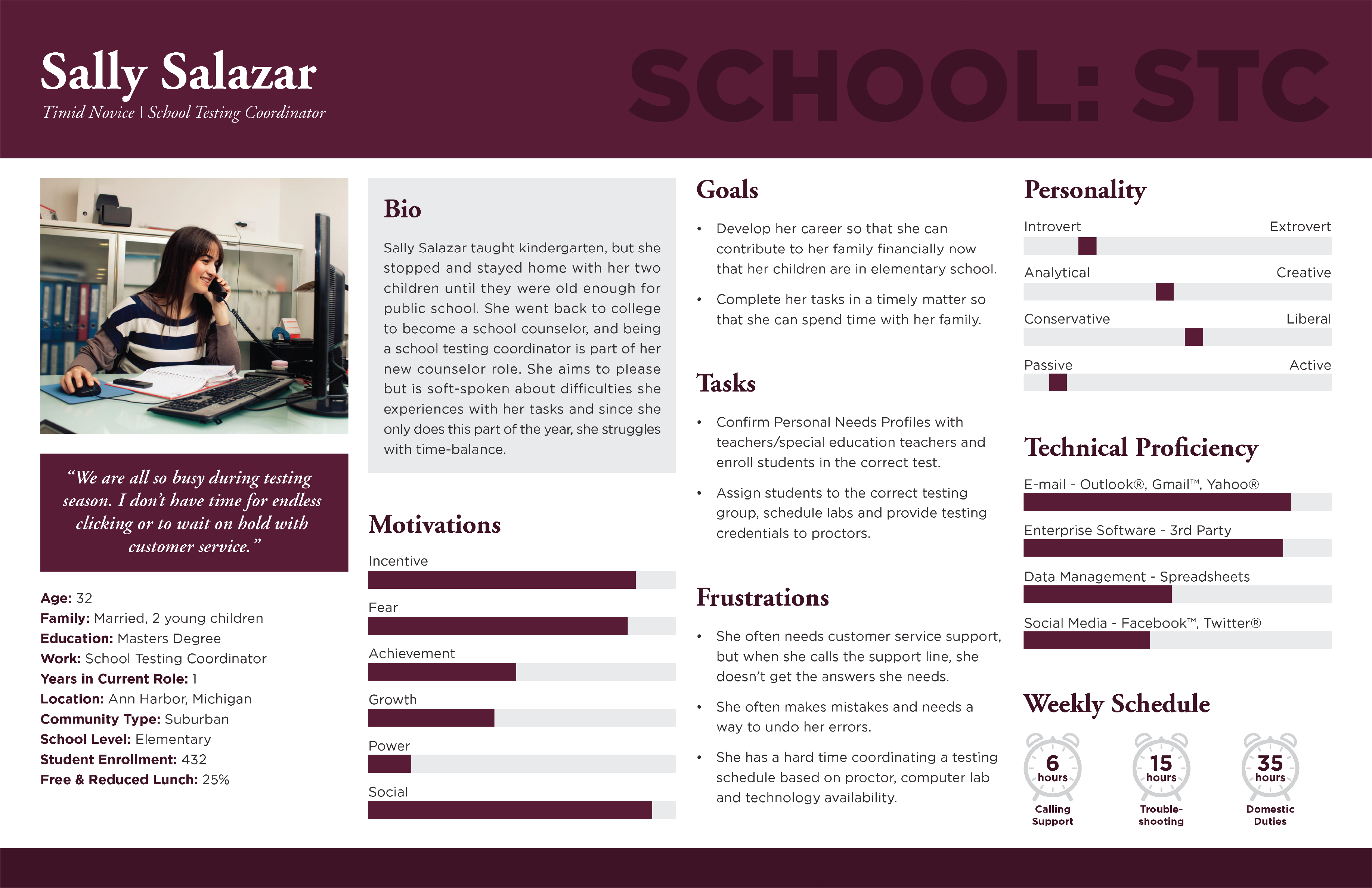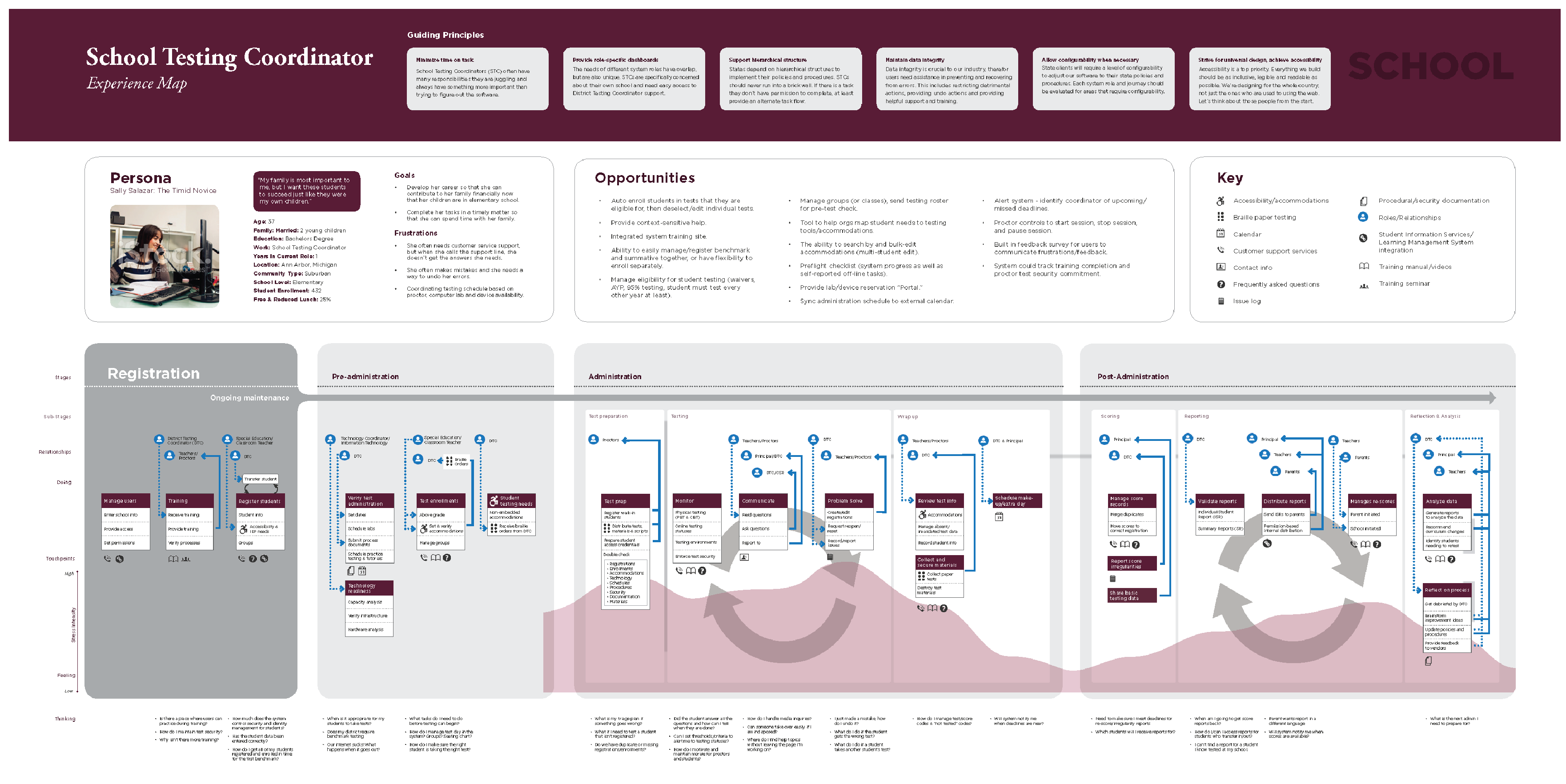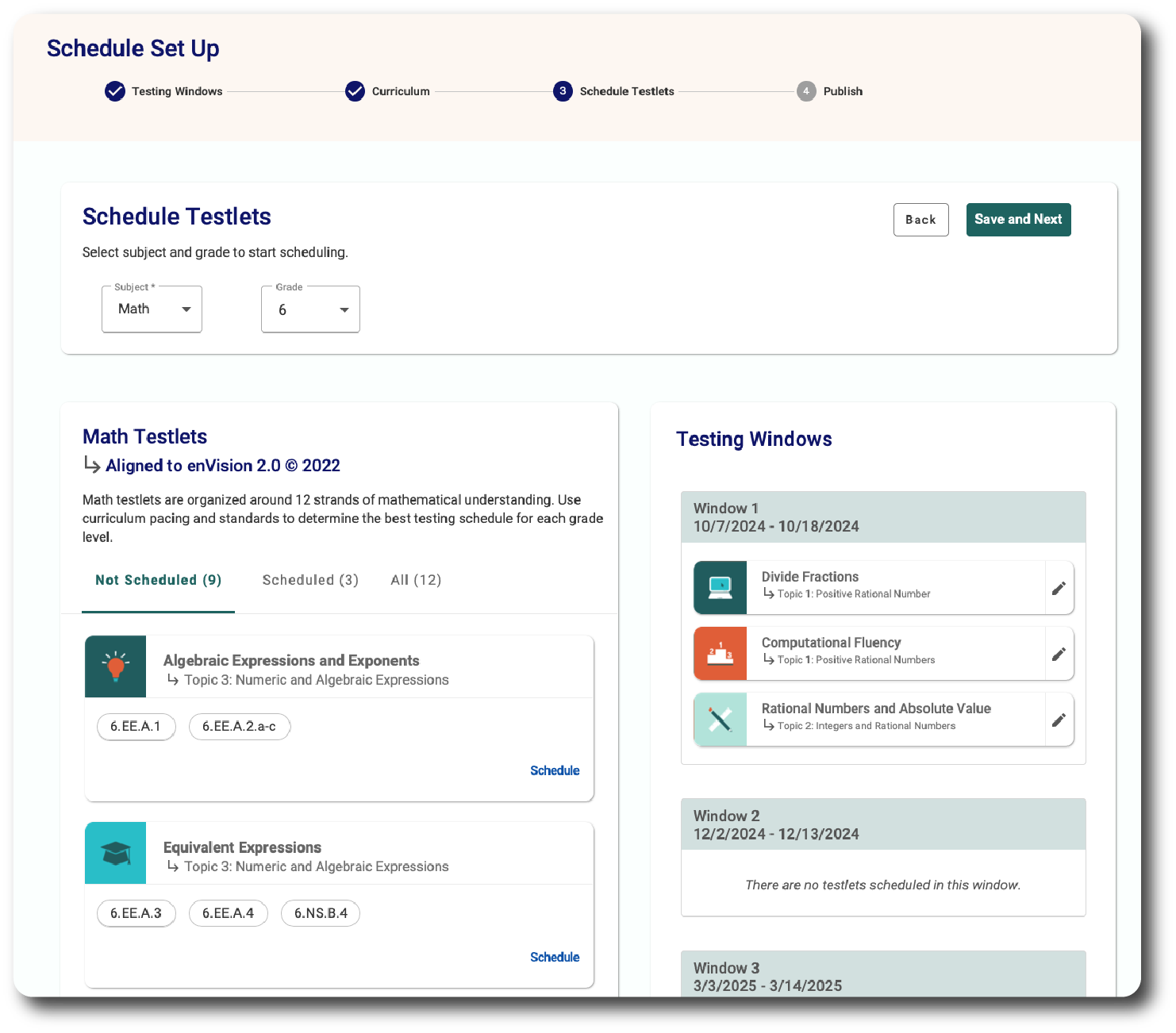
Waypoint Scheduler
My Role
Research, User flows & stories, Sketching, Wireframing, Visual Design, Prototyping, Usability testing
Categories
Application Design
Timeline
Oct. 2023 – Feb. 2024
Overview
001
Empowering Educators: Waypoint Test Administration Application
Waypoint is an online Test Administration application designed to assist teachers in understanding students’ needs, tailoring their learning experience, and tracking progress throughout the academic year. It enables teachers to address each student’s individual level and offers data insights to enhance their learning outcomes in preparation for end-of-year testing.
New Meridian wanted to build a test administration application to establish a comprehensive experience allowing school districts to schedule Testlets (assessments) tailored to their local curriculum and learning progressions, ensuring students are tested on the material they have been taught. Teachers can conduct testing sessions and access reports, while districts can monitor and assess metrics as required. Schools can manage class requirements aligned with their students’ needs and state standards.
The Problem
Design a user-friendly interface for Waypoint that allows state and school district users to efficiently generate schedules for interim testlets by defining testing windows and selecting curriculum.
The Outcome
I designed a scheduling tool that served as the foundation for the entire application. My solution significantly enhanced processes and boosted user flow and functionality by 100%.
Design Process
I conducted extensive research to understand the project requirements thoroughly. Creating personas and user roles permissions, I led Design Studio Sessions to establish user flows and synthesis ideas into a cohesive MVP. Subsequently, I established a design system, mentored a junior designer, and produced high-fidelity mockups. Collaborating closely with developers and product managers, I delivered a solution aimed at enhancing their workflow. Additionally, I spearheaded usability testing, resulting in an impressive 85% increase in optimization. This design framework serves as a cornerstone for future design endeavors.
Project Initiation and Exploration
002
Understanding Scheduler and K-12 Curriculum
To kick off this project, I delved into understanding Scheduler. I engaged in discussions with the product and development team, along with the CTO, to grasp the project’s background and design choices. Prior to my involvement, mock-ups were crafted in Visio and shared with an external UX agency. However, the final outcome fell short of the team’s expectations, prompting them to enlist my expertise.
It was evident that there were gaps to bridge, and my foremost objective was to comprehend the team’s preferences and concerns regarding the designs.
Subsequently, I took the initiative to immerse myself in Scheduler and initiated a comprehensive competitive analysis. These initial steps were instrumental in acquainting me with the intricacies of the K-12 curriculum and the pre-school year preparations undertaken by district leaders. Creating a timeline allowed me to fully understand the problem.
USer Research
003
Research Insights
004
Personas
Role-Based Journey Mapping:
005
Enhancing Understanding and Decision-Making
Core Users and Workflow Challenges
I worked closely with both the product and sales and marketing teams to gain insights into our primary users, their working environment, and the key tasks they aim to accomplish. By collecting data on our users’ existing workflows and significant challenges, we identified opportunities for potential solutions.
01. What is the Context?
02. What are the major task?
03. What are the major curriculum selection issues?
04. What are the primary challenges with selecting testing windows?
05. How do you update a schedule?
06. What are the major scheduling issues?
Reframing the problem
006
How can we empowers districts to build a curriculum schedule that simplifies the process of generating testing windows and ensuring alignment of testlets with their unique local curriculum and sequence?
Problem Space
007
Identifying Critical User Tasks and Challenges
Derived from comprehending Core Users and Workflow Challenges, numerous critical issues demanded attention. I meticulously documented each one. Among these, I identified three primary user tasks and categorized every issue and discovery under the respective task.
01. Curricula Selection
District can select their curriculum for each grade level and align testlets accordingly.
Flexibility to not schedule all testlets
Schools can have more than 1 curriculum for each grade.
Generic curriculum selection (ad hoc)
Allowing district to let children organization(schools) select their curricula and schedule them.
02. Testing Window
Creating testing windows within the school year
Having the ability to edit testing windows due to weather and/or national disasters.
03. Scheduling
Units are used to organize the testlets
Drag and drop would be ideal
Display of standards for each testlet alongside an additional information document.
Ease to edit your schedule.
EXPLORING POSSIBILITIES
008
Ideation: Prioritizing Quantity for Effective Solutions
Focusing on idea generation, I aimed to explore a wide range of possibilities to select the most practical and impactful solutions aligned with user needs. During our Design Studio sessions, we emphasized simplicity, outlining a streamlined process with five key areas to address.
01. Establish testing windows
02. Select Curriculum
03. Schedule Testlets
04. Publish Schedule
05. Edit Schedule
Design Sessions
I collaborated with project stakeholders to prioritize features based on their impact on user experience and business goals, identifying essential elements for the initial launch and postponing non-essential ones for future updates. This streamlined our efforts to deliver a polished experience within our timeframe. Additionally, I facilitated open communication and collaboration within the cross-functional team, ensuring regular check-ins to address progress, overcome obstacles, and adjust course when necessary. Transparent communication helped align priorities, manage expectations, and achieve our goal of timely delivery of a high-quality product.
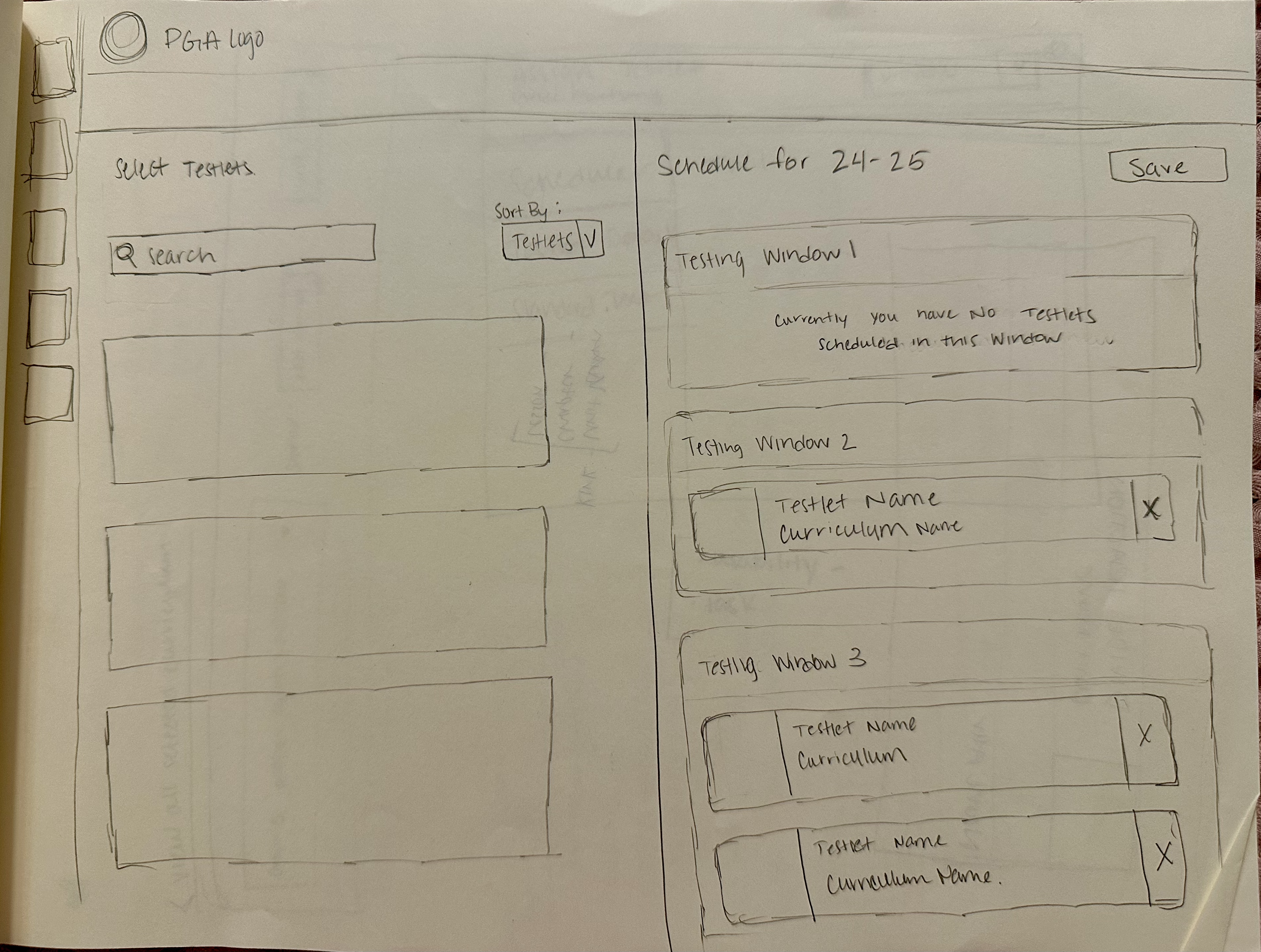
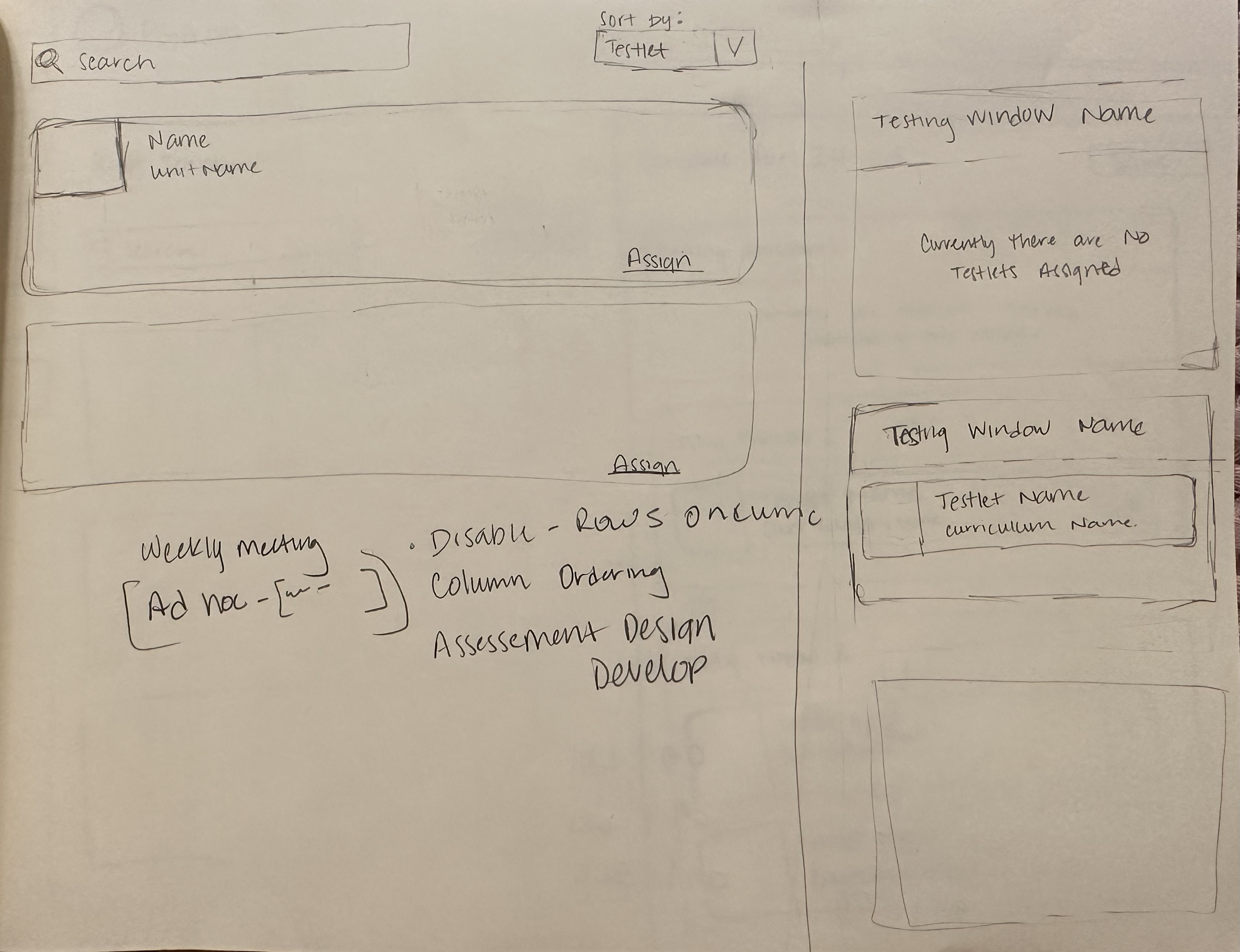
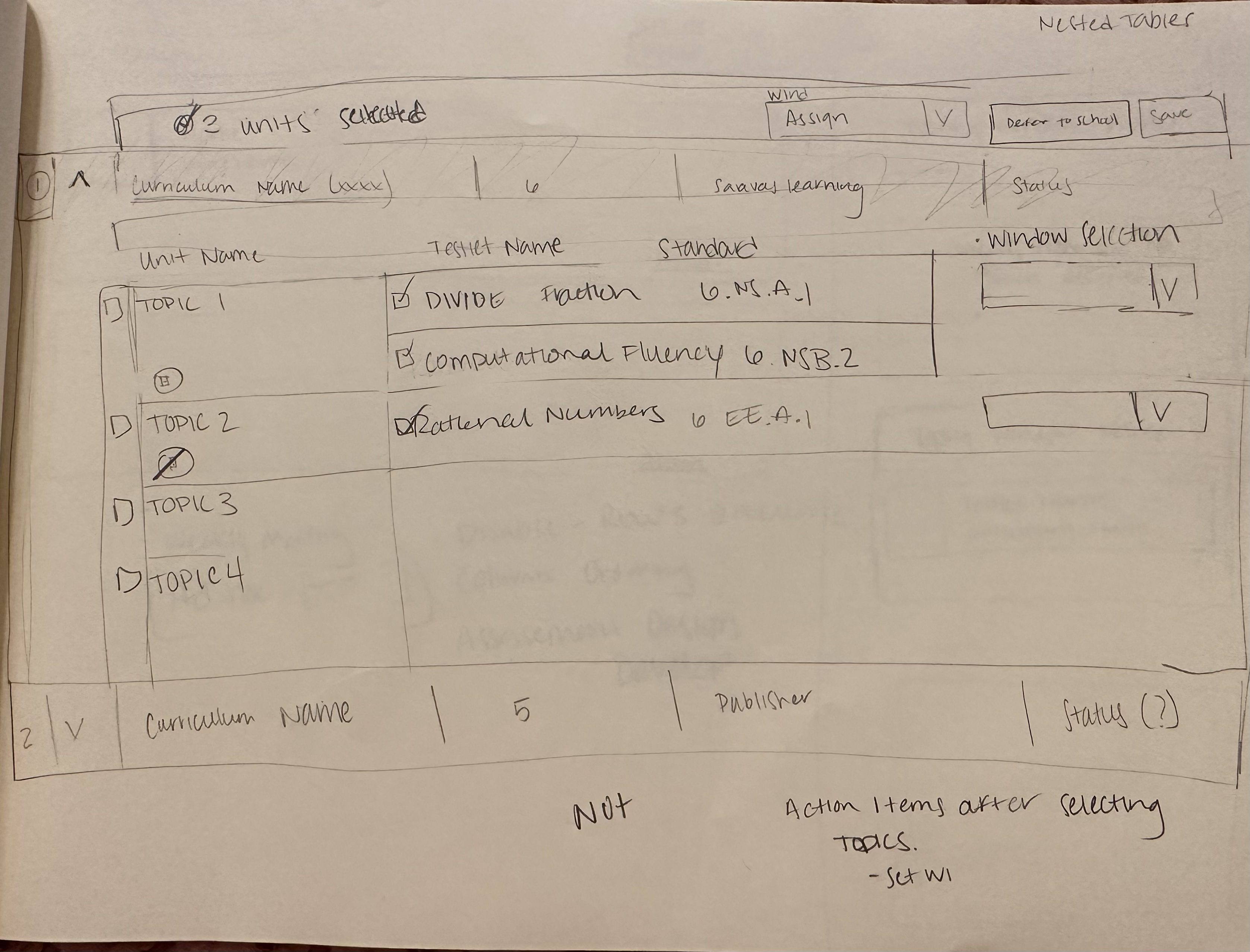
Step 1
009
Establishing Testing Windows
District and state users will establish testing windows ahead of the school year
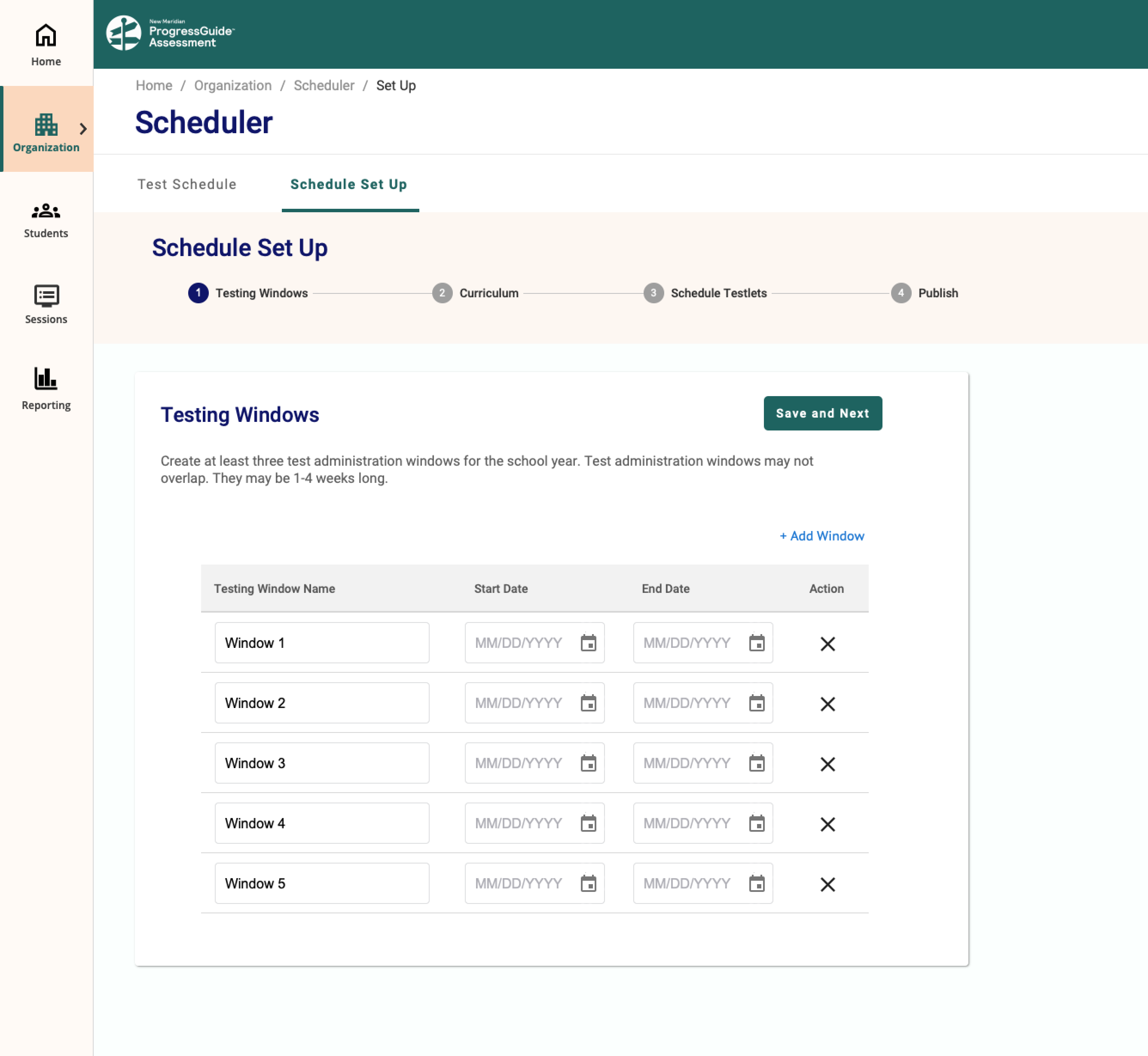
Step 2
009
Selecting Curriculum
The interface provides districts with two options: either implementing standardized testing schedules universally or assigning the scheduling task to Building Test Coordinators. Additionally, selecting Math curriculum automatically aligns testlets with relevant units for scheduling convenience. In cases where a district utilizes a unique or unlisted curriculum, the option to choose “Local Curriculum” is available.
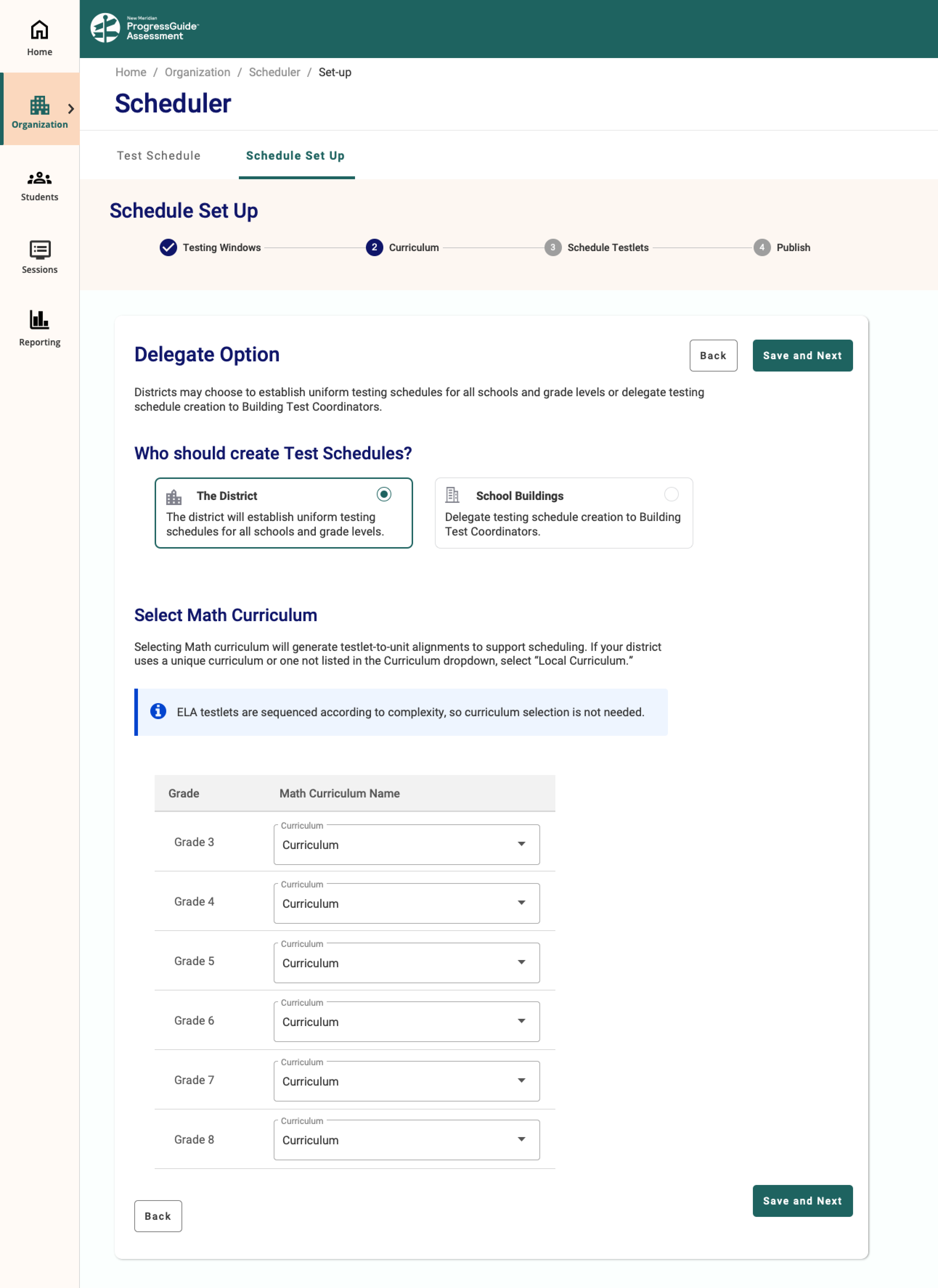
Step 3
010
Aligning Testlets to Bulid a Schedule
The design prompts users to begin scheduling by selecting the subject and grade. Testlets are categorized based on 12 strands of mathematical understanding, representing grade-level content. Users can utilize curriculum pacing and standards to optimize the testing schedule for each grade level. If a publisher curriculum is selected, the interface automatically provides testlet-to-unit alignments to facilitate scheduling.

Step 4
011
Publish Schedule
Users can view their saved updates and track remaining tasks as they build their schedule on this screen. This feature aids in identifying pending actions. Once the schedule is complete, users have the option to publish it to all schools within their District or State.
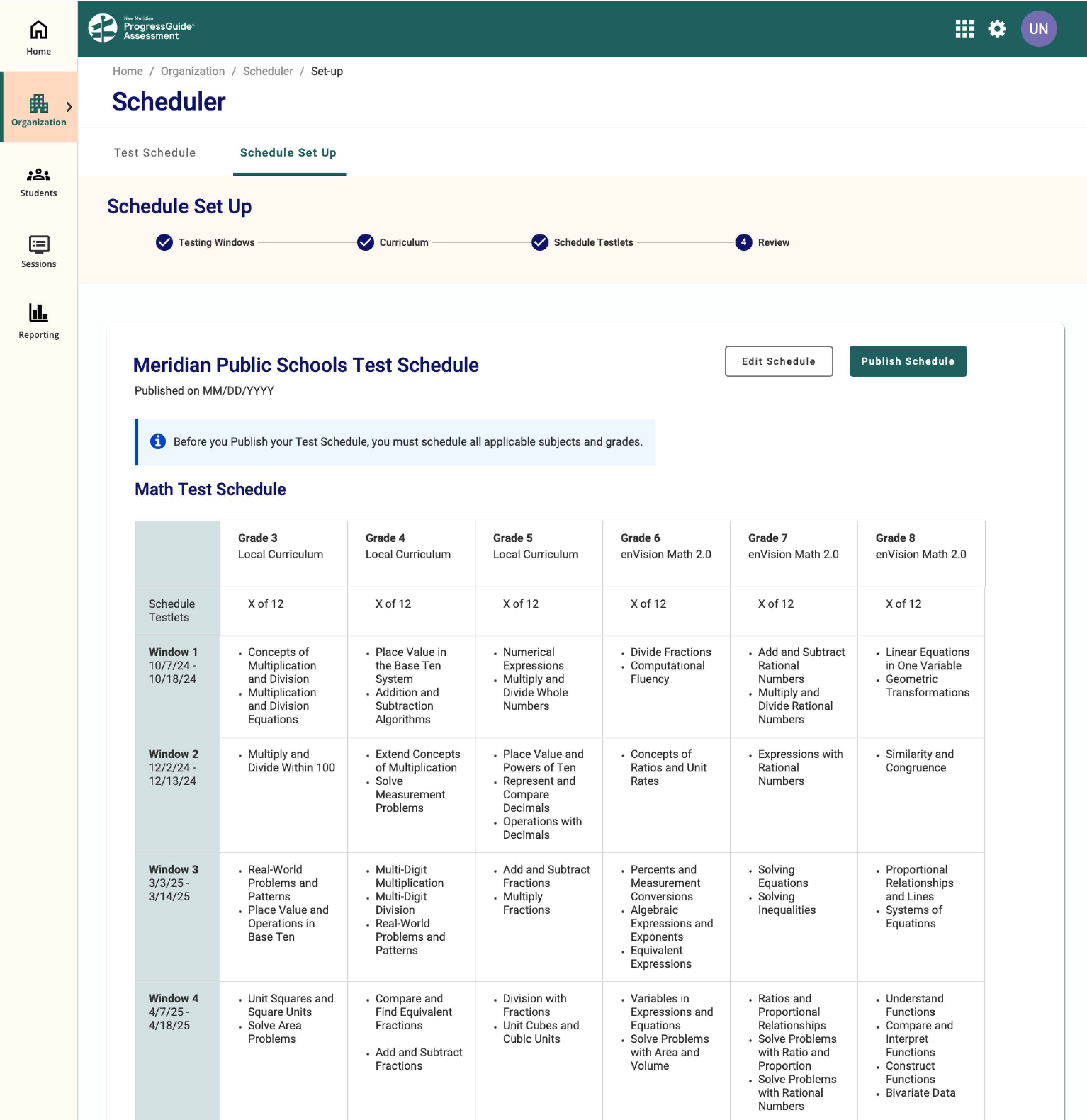
Testing
012
Usability Testing
Even though each component has been tested for usability, I wanted to make sure the full experience worked and made sense. I conducted a full usability test with 8 people. During the session all District users were asked to do several tasks related to creating testing windows, selecting curriculum, scheduling testlets that aligned to their local scopes and sequences, publishing their schedule and editing the schedule.
I am so happy with the results. The users were able to understand how to use the schedule and saw the value. There were significant results on all tasks.
Lessons Learned
013
Reflection
In conclusion, our project journey has been characterized by thorough research, collaborative design efforts, and a relentless focus on user needs. By prioritizing simplicity and innovation, we’ve crafted a solution that not only addresses current challenges but also sets the stage for future advancements. Together, we’ve paved the way for a more efficient and user-centric experience, marking the culmination of our collective dedication and expertise.
Include PM & developers in the design process
UX is the responsibility of the whole product team, not only the designer. To improve collaboration I tried to involve the developers in testing sessions and engaged them in design process. They often had a better understanding of data, edge cases and other parts that I missed.
Constraints help us focus on what matters
By paying attention to constraints – and working within the creative space they afford us – it’s possible to create something slim and functional that users will adopt. Constraints can guide decisions and resolve ambiguity.
Projects get messy
Lots of changes can make a project very messy. They can also impact the measurement of final metrics. Each change should be paired with a metric we intend to improve.
Get feedback & test early to find problems
I conducted 2 rounds of testing to ensure we build the right product. Development started only after usability issues were addressed. It helped me to validate assumptions and uncover hidden issues using actual user feedback.
kudos
014
Praise and Acknowledgment
Shivani is a fantastically creative UX designer with a rock-solid understanding of UX design principles and best practices. She consistently impressed me with her ability to translate user needs into elegant and user-friendly experiences. Her organizational skills, artistic vision, and deep empathy with users make her one of the best designers I’ve worked with in my 20 year career.
Shivani’s passion for UX design extends beyond her own work. She generously mentored several others on our team, sharing her expertise in UX design principles and industry-standard software. Her mentorship played a significant role in her professional development.
In addition to an outstanding professional performance, personally, Shivani has been a pleasure to work with on a daily basis. She is enthusiastic, willing to learn new things, and worked well with others across our organization. I wholeheartedly recommend her for any UX design opportunity.
Shivani is an exceptional UX Designer. I was privileged to work with her in designing a novel tool for K-12 assessment that included solving several challenging design problems. Shivani and I spent many hours together collaborating and brainstorming ways to make the users’ experiences intuitive and delightful. She is adept at translating broad ideas about what a user needs to accomplish into concrete, functional designs and experiences. She is always willing to share her expertise to help the people around her and the organization she works for to grow, including sharing best practices in design, helping others to learn design tools like Axure, and mentoring staff from related fields who have UX-related professional development goals. Shivani would be a great addition to any team. I hope I am lucky enough to work with her again in the future.
Additional Discussion
015
Points which are not convered in this case study but could be worth discussing in person:
-
-
- User Testing Evaluation
- Product strategy and Project timeline
- Internal Design critiques and feedback
- Database inquiries
- Application front-end development
-
